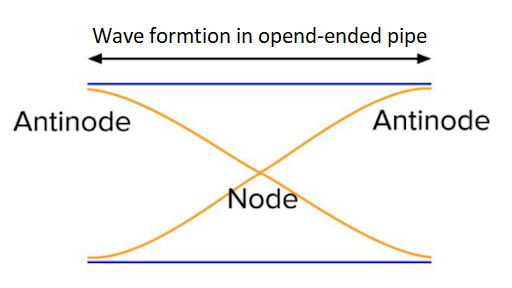
If we study the vibration of a pipe open at both ends, then the following statement is not true
A. Open end with be the anti-node
B. Odd harmonics of the fundamental frequency will be generated
C. All harmonics of the fundamental frequency will be generated.
D. Pressure change will be maximum at both ends
Answer
556.8k+ views
Hint: In these cases, the air inside the tube or pipe vibrates and the air particles vibrate parallel to the walls of the pipe and it results in longitudinal standing waves of different harmonics are generated inside the pipe. These waves reflect from the walls of the, in case of close ended pipes. These ends create nodes and antinodes in the standing waves. The open end of the pipe is at atmospheric pressure, since it is in direct contact with the atmosphere.
Complete step by step answer:
There are many instruments’ that use the principle of vibrating air columns’ inside a pipe or tube. The flute, trombone etc being some of them. In these cases, the air inside the tube or pipe vibrates and the air particles vibrate parallel to the walls of the pipe and it results in longitudinal standing waves of different harmonics are generated inside the pipe. These waves reflect from the walls of the, in case of close ended pipes.
In the question the pipe mentioned is open ended. The waves formed will be as shown in the diagram.

As can be clearly seen from the diagram the open ends are anti nodes. So option A is true.
The harmonics formed will have the form
\[f=\dfrac{nv}{\lambda }\], where n is the number of harmonics.
n can take values of all positive integers. So, all harmonics of the fundamental frequency will be generated. Option B and C are true.
Since the pipes are open ended the ends will have constant pressure which will be equal to the atmospheric pressure. So, option D is not true.
Therefore Option D is our answer.
Note: The waves formed in pipes are results of the change in pressure due to the displacement of air particles. This displacement of air particles and pressure are opposite to each other, this is due to the fact that air particles move where pressure is steady and pressure fluctuates rapidly where particles are not allowed to move freely. These displacement and pressure are important for solving problems as they give indication towards the nature of standing waves formed.
Complete step by step answer:
There are many instruments’ that use the principle of vibrating air columns’ inside a pipe or tube. The flute, trombone etc being some of them. In these cases, the air inside the tube or pipe vibrates and the air particles vibrate parallel to the walls of the pipe and it results in longitudinal standing waves of different harmonics are generated inside the pipe. These waves reflect from the walls of the, in case of close ended pipes.
In the question the pipe mentioned is open ended. The waves formed will be as shown in the diagram.

As can be clearly seen from the diagram the open ends are anti nodes. So option A is true.
The harmonics formed will have the form
\[f=\dfrac{nv}{\lambda }\], where n is the number of harmonics.
n can take values of all positive integers. So, all harmonics of the fundamental frequency will be generated. Option B and C are true.
Since the pipes are open ended the ends will have constant pressure which will be equal to the atmospheric pressure. So, option D is not true.
Therefore Option D is our answer.
Note: The waves formed in pipes are results of the change in pressure due to the displacement of air particles. This displacement of air particles and pressure are opposite to each other, this is due to the fact that air particles move where pressure is steady and pressure fluctuates rapidly where particles are not allowed to move freely. These displacement and pressure are important for solving problems as they give indication towards the nature of standing waves formed.
Recently Updated Pages
Master Class 11 Business Studies: Engaging Questions & Answers for Success

Master Class 11 Computer Science: Engaging Questions & Answers for Success

Master Class 11 Maths: Engaging Questions & Answers for Success

Master Class 11 Chemistry: Engaging Questions & Answers for Success

Master Class 11 Economics: Engaging Questions & Answers for Success

Master Class 11 Accountancy: Engaging Questions & Answers for Success

Trending doubts
What is meant by exothermic and endothermic reactions class 11 chemistry CBSE

1 Quintal is equal to a 110 kg b 10 kg c 100kg d 1000 class 11 physics CBSE

What are Quantum numbers Explain the quantum number class 11 chemistry CBSE

What is periodicity class 11 chemistry CBSE

Explain zero factorial class 11 maths CBSE

Mention the basic forces in nature class 11 physics CBSE




